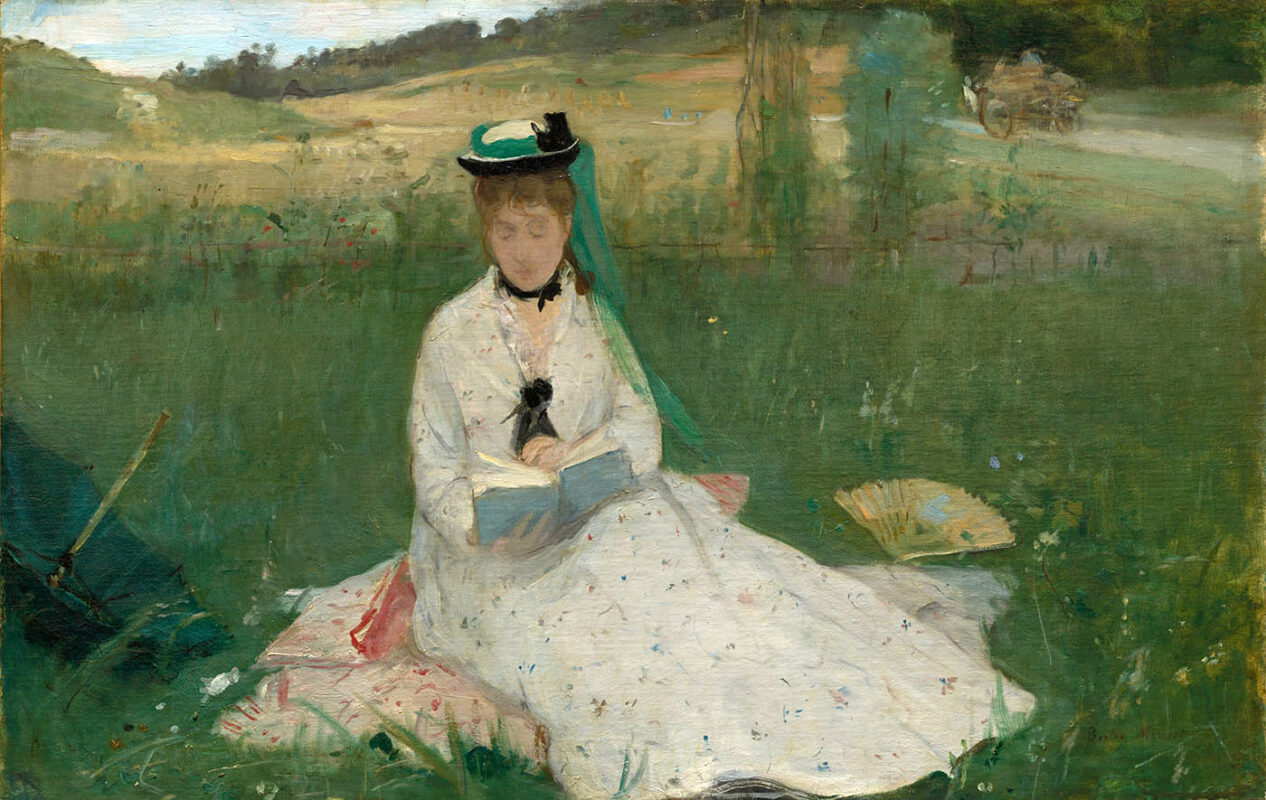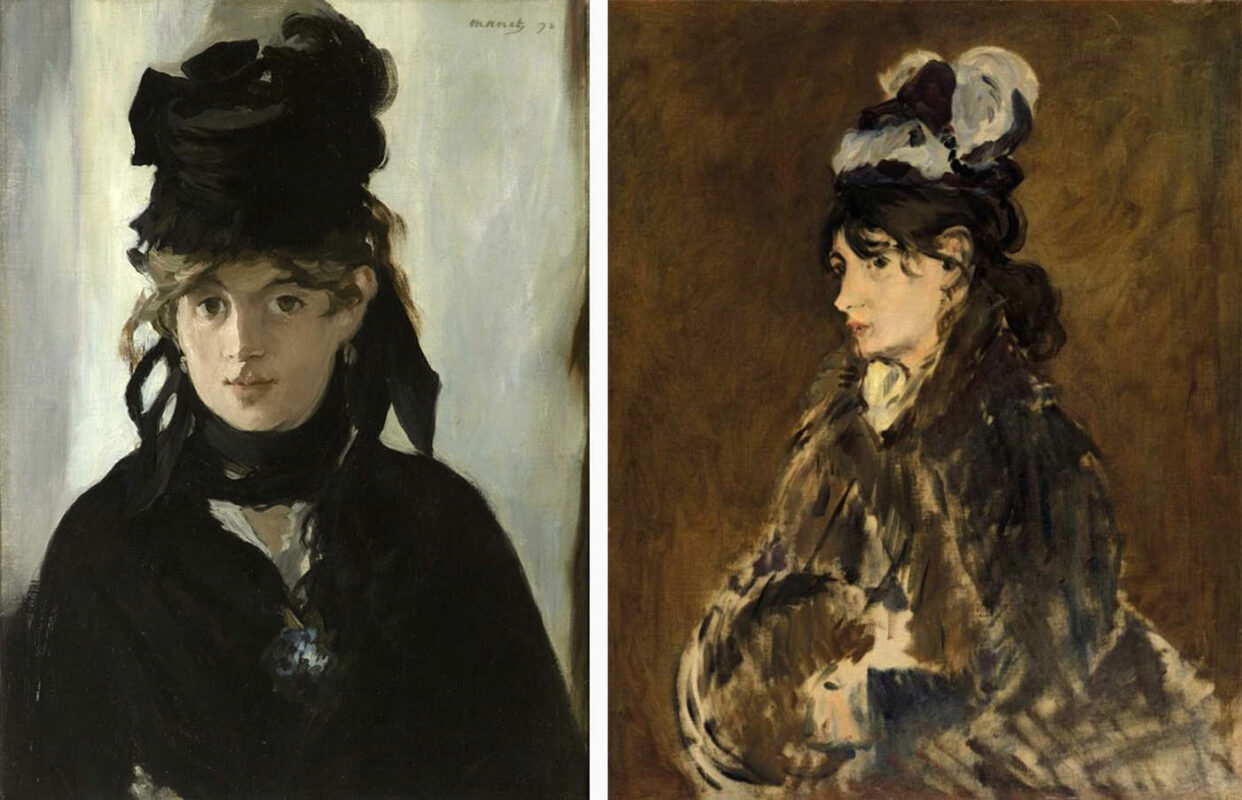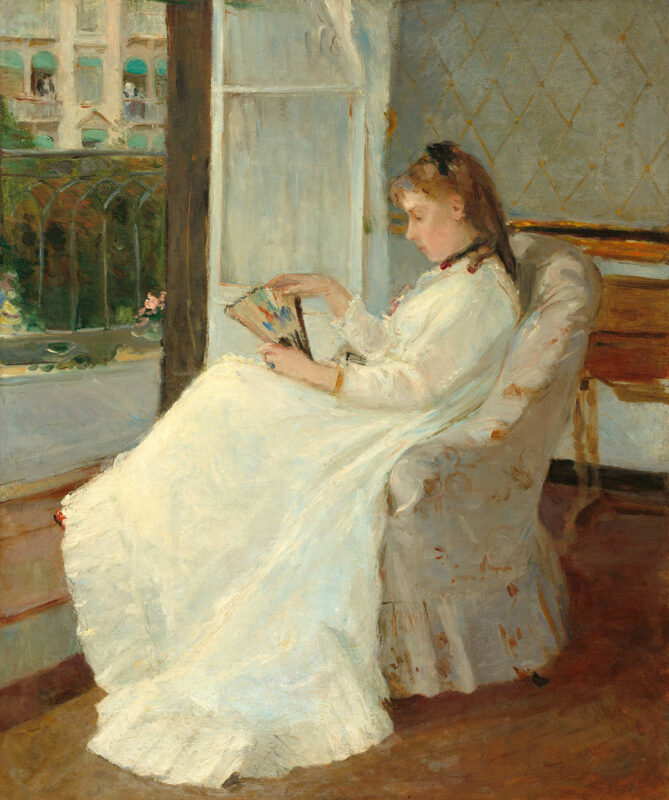
Less known than male counterparts such as Claude Monet, Edgar Degas, or Auguste Renoir, Berthe Morisot is one of the founding members of Impressionism. A close friend of Édouard Manet, she was one of the most innovative Impressionists.
Berthe was undoubtedly not destined to become a painter. Like any other young lady of the upper-class, she had to make an advantageous marriage. Instead, she chose a different path and became a famous figure of Impressionism.
Berthe Morisot And Her Sister Edma: Rising Talents

Berthe Morisot was born in 1841 in Bourges, 150 miles south of Paris. Her father, Edme Tiburce Morisot, worked as departmental prefect of Cher in the Centre-Val de Loire region. Her mother, Marie-Joséphine-Cornélie Thomas, was the niece of Jean-Honoré Fragonard, a well-known Rococo painter. Berthe had a brother and two sisters, Tiburce, Yves, and Edma. The latter shared the same passion as her sister for painting. While Berthe pursued her passion, Edma gave it up when she married Adolphe Pontillon, Lieutenant of the Navy.
In the 1850s, Berthe’s father started working at the French National Court of Audit. The family moved to Paris, France’s capital. The Morisot sisters received the complete education suited for the upper-bourgeoisie women, taught by the best teachers. In the 19th century, women of their birth were expected to make advantageous weddings, not pursue a career. The education they received consisted in piano and painting lessons, among others. The goal was to make young women of the higher society and occupy themselves with artistic activities.
Marie-Joséphie-Cornélie enrolled her daughters Berthe and Edma in painting lessons with Geoffroy-Alphonse Chocarne. The sisters quickly showed a taste for avant-garde painting, making them dislike their teacher’s Neoclassical style. As the Academy of Fine Arts did not accept women until 1897, they found another teacher, Joseph Guichard. The two young ladies had great artistic talent: Guichard was convinced they would become great painters; how unusual for ladies of their wealth and condition!
Get the latest articles delivered to your inbox
Sign up to our Free Weekly Newsletter

Edma and Berthe furthered their artistic education with French painter Jean-Baptiste-Camille Corot. Corot was a founding member of the Barbizon school, and he promoted plein-air painting. That was the reason why the Morisot sisters wanted to learn from him. During the summer months, their father Edme Morisot rented a country house in Ville-d’Avray, West of Paris, so his daughters could practice with Corot, who became a family friend.
Edma and Berthe had several of their paintings accepted at the Parisian Salon of 1864, a real accomplishment for artists! Yet her early works showed no real innovation and depicted landscapes in the manner of Corot. Art critics noted the resemblance with Corot’s painting, and the sister’s work went unnoticed.
In The Shadow Of Her Dear Friend Édouard Manet

Like several 19th-century artists, the Morisot sisters regularly went to the Louvre to copy the old masters’ works. In the museum, they met other artists such as Édouard Manet or Edgar Degas. Even their parents socialized with the upper bourgeoisie involved in the artistic avant-garde. The Morisot often dined with the Manet and Degas families and other eminent personalities such as Jules Ferry, a journalist active in politics, who later became France’s Prime Minister. Several bachelors called on the Morisot sisters, giving them plenty of suitors.
Berthe Morisot developed a strong friendship with Édouard Manet. As the two friends often worked together, Berthe was seen as Édouard Manet’s student. Manet was happy with this – but it angered Berthe. So did the fact that Manet sometimes heavily touched up her paintings. Still, their friendship remained unchanged.
She posed for the painter on several occasions. The lady who always dressed in black, except for a pair of pink shoes, was considered a real beauty. Manet made eleven paintings with Berthe as a model. Were Berthe and Édouard lovers? No one knows, and it is part of the mystery surrounding their friendship and Manet’s obsession for Berthe’s figure.

Berthe eventually married his brother, Eugène Manet, in December 1874, at the age of 33. Édouard made his last portrait of Berthe wearing her wedding ring. After the wedding, Édouard stopped portraying her new sister-in-law. Unlike her sister Edma, who became a housewife and gave up painting after she married, Berthe kept on painting. Eugène Manet was utterly devoted to his wife and encouraged her to pursue her passion. Eugène and Berthe had a daughter, Julie, who appeared in many of Berthe’s later paintings.
Although several critics put that Édouard Manet greatly influenced Berthe Morisot’s work, their artistic relationship likely went both ways. Morisot’s painting notably influenced Manet. Still, Manet never represented Berthe as a painter, only as a woman. Manet’s portraits had a sulfurous reputation at the time, but Berthe, a real modern artist, understood his art. Berthe let Manet use her figure to express his avant-garde talent.
Depicting Women And Modern Life

Berthe perfected her technique while painting landscapes. From the end of the 1860s onwards, portrait painting struck her interest. She often painted bourgeois interior scenes with windows. Some experts have seen this kind of representation as a metaphor for 19th-century upper-class women’s condition, locked in their beautiful houses. The end of the 19th century was a time of codified spaces; women ruled inside their homes, while they could not go outside without chaperoning.
Instead, Berthe used windows to open the scenes up. In this way, she could bring light into the rooms and blur the limit between inside and outside. In 1875, while on her honeymoon on the Isle of Wight, Berthe painted a portrait of her husband, Eugène Manet. In this painting, Berthe reversed the traditional scene: she depicted the man indoors, looking outside the window towards the harbor, while a woman and her child strolled outside. She erased the limits set between the women’s and the men’s spaces, showing great modernity.

Unlike male counterparts, Berthe had no access to Parisian life, with its thrilling streets and modern cafes. Yet, just like them, she painted scenes of modern life. The scenes painted inside wealthy households were also part of contemporary life. Berthe wanted to represent contemporary life, in stark contrast with academic painting focusing on antique or imaginary subjects.
Women played a crucial role in her work. She depicted females as steady and strong figures. She illustrated their trustworthiness and importance instead of their 19th-century role as their husbands’ mere companions.
A Founding Member Of Impressionism

At the end of 1873, a group of artists, weary of their rejection from the official Parisian Salon, signed the charter for the “Anonymous Society of Painters, Sculptors, and Printmakers.” Claude Monet, Camille Pissarro, Alfred Sisley, and Edgar Degas counted among the signatories.
A year later, in 1874, the group of artists held their first exhibition—a crucial milestone giving birth to Impressionism. Edgar Degas invited Berthe Morisot to take part in this first exhibition, showing his esteem for the woman painter. Morisot held a key role in the Impressionist movement. She worked as an equal with Monet, Renoir, and Degas. The painters valued her work and considered her as an artist and a friend. Her talent and strength inspired them.
Berthe not only chose modern subjects but treated them in a modern way. Like other Impressionists, the subject was not as essential for her as to how it was treated. Berthe tried to capture the changing light of a fleeting moment rather than depicting someone’s true likeness.
From the 1870s onwards, Berthe developed her own color palette. She used lighter colors than in her previous paintings. Whites and silvers with a few darker splashes became her signature. Like other Impressionists, she traveled to the south of France in the 1880s. The Mediterranean sunny weather and colorful sceneries made a durable impression on her painting technique.

With her 1882 painting of the Port of Nice, Berthe brought innovation to outdoor painting. She seated herself on a small fishing boat to paint the harbor. Water filled the lower part of the canvas, while the port occupied the top part. Berthe repeated this framing technique on several occasions. With her approach, she brought great novelty to the painting’s composition. Furthermore, Morisot depicted the scenery in an almost abstract way, showing all her avant-garde talent. Berthe was not a mere follower of Impressionism; she indeed was one of its leaders.

Morisot used to leave parts of the canvas or paper without color. She viewed it as an integral element of her work. In the Young Girl and Greyhound painting, she used colors in a traditional way to depict her daughter’s portrait. But for the rest of the scene, color brushstrokes mix with blank surfaces on the canvas.
Unlike Monet or Renoir, who tried on several occasions to have their works accepted at the official Salon, Morisot always followed an independent path. She considered herself a female artist member of a marginal artistic group: the Impressionists as they were first ironically nicknamed.
The Legitimacy Of Her Work

In 1867, when Berthe Morisot started to work as an independent painter, it was difficult for women to have a career, especially as an artist. Berthe’s dearest friend, Édouard Manet, wrote to painter Henri Fantin-Latour something relevant of 19th-century women’s condition: “I completely agree with you, the young ladies Morisot are charming, such a pity they are not men. Yet, as ladies, they could serve the painting’s cause by marrying members of the Academy and sowing discord in these old stick-in-the-muds’ faction.”
As an upper-class woman, Berthe Morisot was not regarded as an artist. Like other women of her time, she could not have a real career, and painting was just another female leisure activity. Art critic and collector Théodore Duret said that Morisot’s situation in life overshadowed her artistic talent. She was well aware of her skills, and she suffered in silence because, as a woman, she was seen as an amateur.
French poet and critic Stéphane Mallarmé, another of Morisot’s friends, promoted her work. In 1894, he suggested to governmental officers to purchase one of Berthe’s paintings. Thanks to Mallarmé, Morisot had her work exhibited in the Musée du Luxembourg. At the beginning of the 19th century, the Musée du Luxembourg in Paris became the museum exhibiting living artists’ work. Until 1880, academics chose the artists who could display their art in the museum. The political changes with the French Third Republic’s accession and the constant efforts of art critics, collectors, and artists permitted the acquisition of avant-garde art pieces. The museum exhibited the work of Impressionists, including Berthe Morisot, a milestone in the acknowledgment of her talent. Morisot became a true artist in the public’s eye.
Berthe Morisot’s Fall Into Oblivion And Rehabilitation

With Alfred Sisley, Claude Monet, and Auguste Renoir, Berthe Morisot was the only living artist who sold one of her paintings to the French national authorities. However, the French State only bought two of her paintings to keep in their collection.
Berthe died in 1895, aged 54. Even with her prolific and high-level artistic production, her death certificate only mentioned “unemployed.” Her gravestone states, “Berthe Morisot, widow of Eugène Manet.” The following year, an exhibition was organized in memory of Berthe Morisot in the Parisian gallery of Paul Durand-Ruel, an influential art dealer and promoter of Impressionism. Fellow artists Renoir and Degas oversaw the presentation of her work, contributing to her posthumous fame.

Because of being a woman, Berthe Morisot swiftly fell into oblivion. In only a few years, she went from fame to indifference. For almost a century, the public forgot all about the artist. Even eminent art historians Lionello Venturi and John Rewald barely mentioned Berthe Morisot in their bestselling books about Impressionism. Only a handful of shrewd collectors, critics, and artists celebrated her talent.
Only at the end of the 20th century and the beginning of the 21st was the interest in Berthe Morisot’s work reinvigorated. Curators finally dedicated exhibitions to the painter, and scholars started to investigate one of the greatest Impressionists’ life and work.







